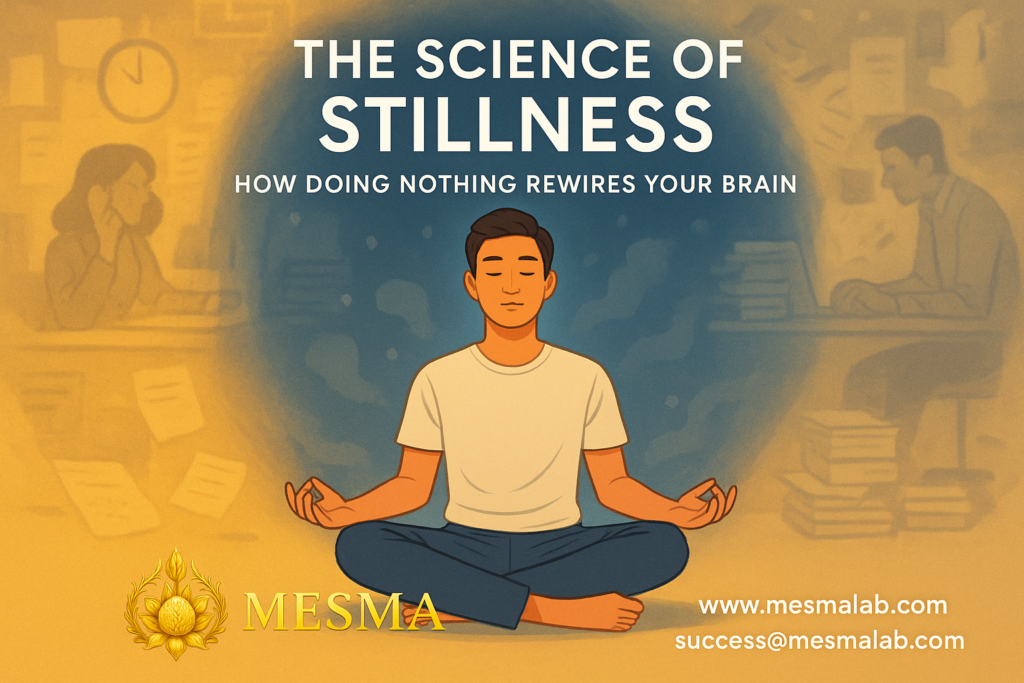“Stillness is not inactivity. It’s deep inner activity.”
— Sathish Sampath, Founder, MESMA Lab
The Science of Stillness: How Doing Nothing Rewires Your Brain
The moment you pause, the guilt creeps in.
The silence becomes uncomfortable.
And you wonder, “Am I wasting time?”
But what if stillness is not just beneficial — what if it’s biologically necessary?
At MESMA Lab, we define stillness not as passivity, but as intentional rest — a deliberate practice to reset your nervous system, clear cognitive noise, and enhance neuroplasticity.
Let’s explore the science behind this misunderstood superpower.
🧠 What Is Stillness, Technically?
Stillness is not just sitting idle — it’s a neurophysiological state of:
- Reduced sympathetic (fight-or-flight) activity
- Increased parasympathetic (rest-and-digest) response
- Alpha and theta brainwave dominance
- Reduced Default Mode Network (DMN) chatter
It’s the brain’s maintenance mode, where repair, reprocessing, and reorganization happen — similar to how deep sleep allows for memory consolidation.
📊 Stillness By the Numbers
- Up to 47% of our waking time is spent in mind-wandering (Harvard Study)
- People who engage in regular stillness practices report:
- 32% reduction in anxiety (JAMA Psychiatry)
- 40% improvement in memory recall (Frontiers in Psychology)
- Up to 20% boost in creativity and problem solving (Stanford GSB)
Stillness is no longer a luxury.
It’s a mental hygiene routine — as essential as brushing your teeth.
🧠 What Happens to the Brain in Stillness?
| Brain Region | Effect of Stillness |
|---|---|
| Amygdala | Calms down → Reduces threat detection hypervigilance |
| Prefrontal Cortex | Enhances → Improves logic, foresight, and calm decision-making |
| Default Mode Network (DMN) | Resets → Reduces rumination and ego-centric chatter |
| Anterior Cingulate Cortex | Activates → Improves focus-switching and emotional resilience |
| Insula | Strengthens → Boosts self-awareness and body intuition |
🔁 MESMA’s NeuroStill™ Framework
At MESMA Lab, we developed the NeuroStill™ Protocol — a science-based approach to cultivating productive stillness.
It is NOT just meditation.
It is a layered, micro-practice-based method combining:
- Breath entrainment
- Sensory quieting
- Somatic awareness
- Cognitive unhooking
- Biofeedback-informed rest states
🌟 The 3 Types of Stillness
| Type | Duration | Purpose | Example |
|---|---|---|---|
| Micro Stillness | 30 sec–3 min | Nervous system reset | Deep sighs, box breathing, eye-gazing pause |
| Mid Stillness | 5–15 min | Mental clarity + emotional reboot | Guided body scan, NSDR, eye-closed sitting |
| Macro Stillness | 20–60 min | Creativity & reprocessing | Nature walk alone, floating, silence reset |
🧘♀️ Stillness Practices to Start Today
✅ 1. Eyes-Closed Sitting (3 minutes)
- Sit still
- Close your eyes
- Let thoughts arise — don’t engage
- Return to breath when distracted
💡 Reduces DMN. Improves emotional balance.
✅ 2. Sensory Audit (5 minutes)
- Sit or stand still
- Identify:
- 3 sounds
- 3 bodily sensations
- 3 smells or visuals
💡 Grounds attention. Quiets external noise.
✅ 3. Guided NSDR (Non-Sleep Deep Rest)
- Use a 10-minute MESMA audio (coming soon)
- Lie flat or recline
- Let voice guide you through body and breath release
💡 Triggers repair mode. Enhances memory consolidation.
✅ 4. Nature-Based Stillness
- Go to a park or sit by a tree
- Observe without photographing or scrolling
- Notice rhythm of breath and body
💡 Improves mood. Activates insula and vagus nerve.
🧑💼 Why Professionals Must Prioritize Stillness
“In high-stakes environments, decisions aren’t made in noise — they’re made in clarity.”
— MESMA Insight
Stillness gives professionals:
- Clearer decisions
- Faster emotional regulation
- Sharper focus during stress
- Greater presence in meetings and communication
- Reduced impulsivity (especially in digital distractions)
Top CEOs, investors, athletes, and military leaders all use stillness as part of their performance routine.
⚙️ The Biology of Stillness: Measurable Benefits
| Parameter | Before Stillness | After 10 Minutes Stillness |
|---|---|---|
| Heart Rate Variability | Low | Higher (more resilient) |
| Cortisol Level | Elevated | Significantly reduced |
| Alpha Brainwaves | Suppressed | Enhanced |
| Skin Conductance (stress) | High | Reduced |
| Mental Fatigue Index | High | Lower |
📡 Biofeedback devices like Muse, HeartMath, and Oura have measured these changes in real-time.
📓 5-Minute Stillness Tracker (Free Template – you can improvise on this and make it specially for you)
| Day | Time Practiced | Where | Stillness Type | 1 Word After |
|---|---|---|---|---|
| Mon | 5 mins | Balcony | Mid Stillness | Clear |
| Tue | 2 mins | At desk | Micro Stillness | Centered |
| Wed | 10 mins | Nature | Macro Stillness | Free |
Try this tracker for a week and notice the patterns in energy, clarity, and decision-making.
💬 Stillness Quotes to Reflect On
“The quieter you become, the more you can hear.” — Ram Dass
“Stillness is the language God speaks.” — Eckhart Tolle
“In the rush to return to normal, use this time to consider which parts are worth rushing back to.” — Dave Hollis
📌 Final Thought
Stillness is not inaction. It’s super-action from within.
It’s where your brain breathes.
It’s where clarity returns.
It’s where burnout begins to reverse.
It’s where strategy replaces stress.
At MESMA Lab, we call stillness the Master Reset Button — and it’s available to anyone, anytime, for free.
The future is not faster. The future is calmer + smarter.
Begin with stillness. End with clarity.
Would you like to discuss with us on this further – feel free to write to us at success@mesmalab.com


